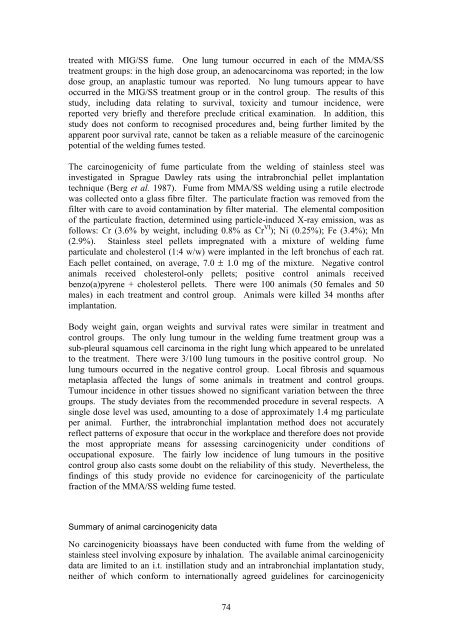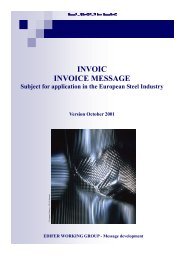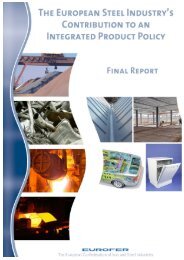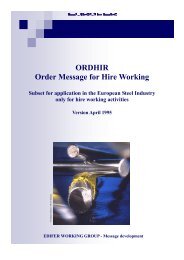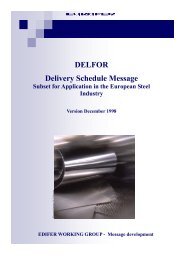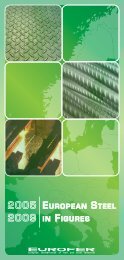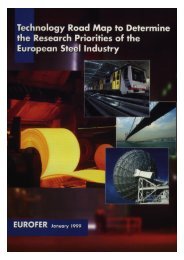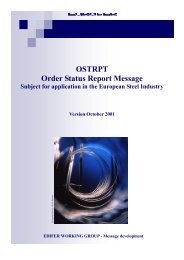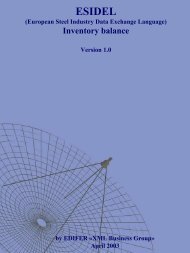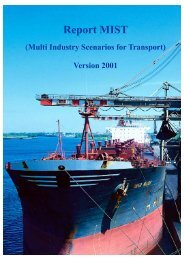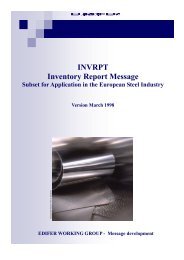manufacture, processing and use of stainless steel - International ...
manufacture, processing and use of stainless steel - International ...
manufacture, processing and use of stainless steel - International ...
You also want an ePaper? Increase the reach of your titles
YUMPU automatically turns print PDFs into web optimized ePapers that Google loves.
treated with MIG/SS fume. One lung tumour occurred in each <strong>of</strong> the MMA/SS<br />
treatment groups: in the high dose group, an adenocarcinoma was reported; in the low<br />
dose group, an anaplastic tumour was reported. No lung tumours appear to have<br />
occurred in the MIG/SS treatment group or in the control group. The results <strong>of</strong> this<br />
study, including data relating to survival, toxicity <strong>and</strong> tumour incidence, were<br />
reported very briefly <strong>and</strong> therefore preclude critical examination. In addition, this<br />
study does not conform to recognised procedures <strong>and</strong>, being further limited by the<br />
apparent poor survival rate, cannot be taken as a reliable measure <strong>of</strong> the carcinogenic<br />
potential <strong>of</strong> the welding fumes tested.<br />
The carcinogenicity <strong>of</strong> fume particulate from the welding <strong>of</strong> <strong>stainless</strong> <strong>steel</strong> was<br />
investigated in Sprague Dawley rats using the intrabronchial pellet implantation<br />
technique (Berg et al. 1987). Fume from MMA/SS welding using a rutile electrode<br />
was collected onto a glass fibre filter. The particulate fraction was removed from the<br />
filter with care to avoid contamination by filter material. The elemental composition<br />
<strong>of</strong> the particulate fraction, determined using particle-induced X-ray emission, was as<br />
follows: Cr (3.6% by weight, including 0.8% as Cr VI ); Ni (0.25%); Fe (3.4%); Mn<br />
(2.9%). Stainless <strong>steel</strong> pellets impregnated with a mixture <strong>of</strong> welding fume<br />
particulate <strong>and</strong> cholesterol (1:4 w/w) were implanted in the left bronchus <strong>of</strong> each rat.<br />
Each pellet contained, on average, 7.0 ± 1.0 mg <strong>of</strong> the mixture. Negative control<br />
animals received cholesterol-only pellets; positive control animals received<br />
benzo(a)pyrene + cholesterol pellets. There were 100 animals (50 females <strong>and</strong> 50<br />
males) in each treatment <strong>and</strong> control group. Animals were killed 34 months after<br />
implantation.<br />
Body weight gain, organ weights <strong>and</strong> survival rates were similar in treatment <strong>and</strong><br />
control groups. The only lung tumour in the welding fume treatment group was a<br />
sub-pleural squamous cell carcinoma in the right lung which appeared to be unrelated<br />
to the treatment. There were 3/100 lung tumours in the positive control group. No<br />
lung tumours occurred in the negative control group. Local fibrosis <strong>and</strong> squamous<br />
metaplasia affected the lungs <strong>of</strong> some animals in treatment <strong>and</strong> control groups.<br />
Tumour incidence in other tissues showed no significant variation between the three<br />
groups. The study deviates from the recommended procedure in several respects. A<br />
single dose level was <strong>use</strong>d, amounting to a dose <strong>of</strong> approximately 1.4 mg particulate<br />
per animal. Further, the intrabronchial implantation method does not accurately<br />
reflect patterns <strong>of</strong> exposure that occur in the workplace <strong>and</strong> therefore does not provide<br />
the most appropriate means for assessing carcinogenicity under conditions <strong>of</strong><br />
occupational exposure. The fairly low incidence <strong>of</strong> lung tumours in the positive<br />
control group also casts some doubt on the reliability <strong>of</strong> this study. Nevertheless, the<br />
findings <strong>of</strong> this study provide no evidence for carcinogenicity <strong>of</strong> the particulate<br />
fraction <strong>of</strong> the MMA/SS welding fume tested.<br />
Summary <strong>of</strong> animal carcinogenicity data<br />
No carcinogenicity bioassays have been conducted with fume from the welding <strong>of</strong><br />
<strong>stainless</strong> <strong>steel</strong> involving exposure by inhalation. The available animal carcinogenicity<br />
data are limited to an i.t. instillation study <strong>and</strong> an intrabronchial implantation study,<br />
neither <strong>of</strong> which conform to internationally agreed guidelines for carcinogenicity<br />
74


